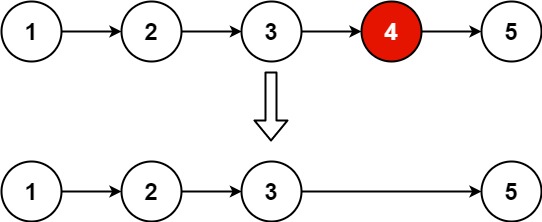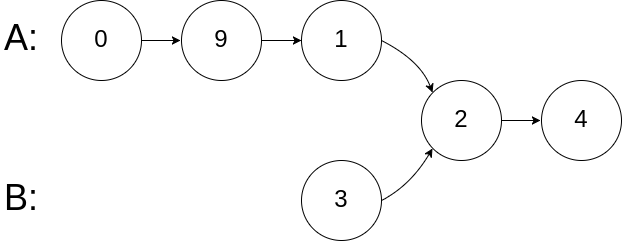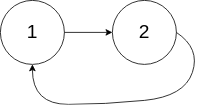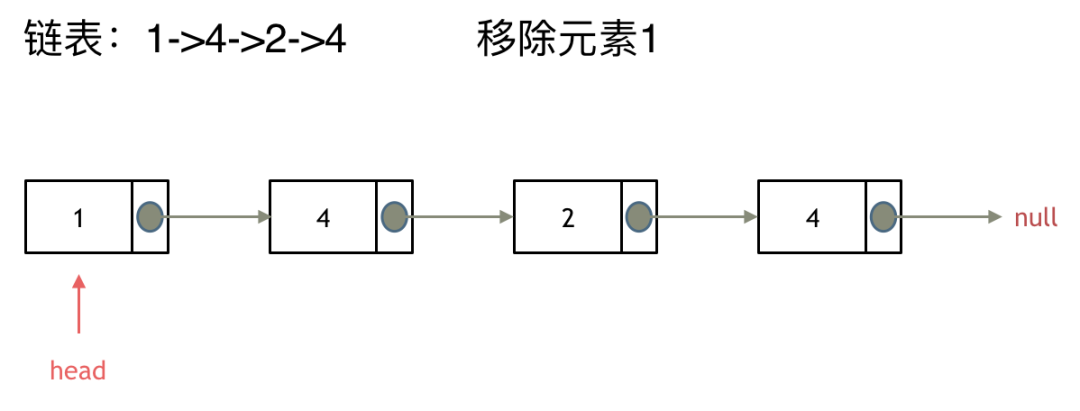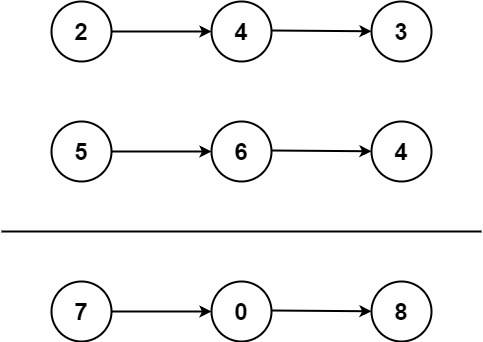设计链表 单链表 设计链表的实现。您可以选择使用单链表或双链表。
单链表中的节点应该具有两个属性:val 和 next。val 是当前节点的值,next 是指向下一个节点的指针/引用。
双向链表,则还需要一个属性 prev 以指示链表中的上一个节点。假设链表中的所有节点都是 0-index 的。
在链表类中实现这些功能:
get(index):获取链表中第 index 个节点的值。如果索引无效,则返回-1。addAtHead(val):在链表的第一个元素之前添加一个值为 val 的节点。插入后,新节点将成为链表的第一个节点。addAtTail(val):将值为 val 的节点追加到链表的最后一个元素。addAtIndex(index,val):在链表中的第 index 个节点之前添加值为 val 的节点。如果 index 等于链表的长度,则该节点将附加到链表的末尾。如果 index 大于链表长度,则不会插入节点。如果index小于0,则在头部插入节点。deleteAtIndex(index):如果索引 index 有效,则删除链表中的第 index 个节点。
单链表结点的实现 1 2 3 4 5 6 7 public class SinglyListNode int val; SinglyListNode next; SinglyListNode(int x) { this .val = x; } }
Leetcode 上的测试代码 1 2 3 4 5 6 7 8 9 10 11 12 13 14 15 16 17 18 19 20 21 22 23 24 25 26 27 28 29 30 31 32 33 34 35 36 37 package linear;public class ListNode int val; ListNode next; ListNode(int x) { this .val = x; } public ListNode (int [] arr) throws Exception if (arr == null || arr.length == 0 ) throw new Exception("arr can not be empty" ); this .val = arr[0 ]; ListNode cur = this ; for (int i = 1 ; i < arr.length; i++) { cur.next = new ListNode(arr[i]); cur = cur.next; } } @Override public String toString () StringBuilder res = new StringBuilder(); ListNode cur = this ; while (cur != null ) { res.append(cur.val + "->" ); cur = cur.next; } res.append("NULL" ); return res.toString(); } }
创建ListNode结点类(核心一个存value,一个存引用地址)
构造参数,以接受不同的输入 (这里核心是需要接收Array的格式,然后将值转换成链表)
重写toString 的方法,以适合打印print
结果
1 2 3 4 5 2->4->3->NULL 5->6->4->NULL 7->0->8->NULL
单链表实现 1 2 3 4 5 6 7 8 9 10 11 12 13 14 15 16 17 18 19 20 21 22 23 24 25 26 27 28 29 30 31 32 33 34 35 36 37 38 39 40 41 42 43 44 45 46 47 48 49 50 51 52 53 54 55 56 57 58 59 60 61 62 63 64 65 66 67 68 69 70 71 72 73 74 75 76 77 78 79 80 81 82 83 84 85 86 87 88 89 90 91 92 93 94 95 96 97 98 99 100 101 102 103 104 105 106 107 108 109 110 111 112 113 114 115 116 117 118 119 120 121 122 class MyLinkedList class Node int val; Node next; Node(int val) { this .val = val; } } int size; Node head; public MyLinkedList () this .size = 0 ; this .head = null ; } public int get (int index) if (index <0 || index >= size|| head == null ){ return -1 ; } Node temp = this .head; for (int i = 0 ; i<index; i++){ temp = temp.next; } return temp.val; } public void addAtHead (int val) Node node = new Node (val); node.next= this .head; this .head = node; size ++; } public void addAtTail (int val) if (size==0 ){ this .head = new Node (val); head.next= null ; size++; }else { Node temp = this .head; while (temp.next!=null ){ temp = temp.next; } Node tail = new Node(val); tail.next =null ; temp.next =tail; size++; } } public void addAtIndex (int index, int val) if (index>this .size){ return ; } if (index<=0 ){ addAtHead(val); return ; } if (index==this .size){ addAtTail(val); return ; } Node temp = this .head; for (int i = 0 ; i <index-1 ;i++){ temp = temp.next; } Node insertNode = new Node(val); insertNode.next = temp.next; temp.next = insertNode; size ++; } public void deleteAtIndex (int index) if (index < 0 || index >= this .size) { return ; } if (index == 0 ) { if (size != 1 ) { Node temp = this .head.next; this .head =temp; size--; return ; }else { this .head = null ; size--; return ; } } Node temp = this .head; for (int i = 0 ; i < index - 1 ; i++) { temp = temp.next; } Node deleteNode = temp.next; temp.next = deleteNode.next; size--; } }
Reference: https://leetcode-cn.com/leetbook/read/linked-list/jy291/
LeetCode 算法实战 19. 删除链表的倒数第 N 个结点 难度中等1424收藏分享切换为英文接收动态反馈
给你一个链表,删除链表的倒数第 n 个结点,并且返回链表的头结点。
进阶: 你能尝试使用一趟扫描实现吗?
示例 1:
1 2 输入:head = [1,2,3,4,5], n = 2 输出:[1,2,3,5]
示例 2:
1 2 输入:head = [1], n = 1 输出:[]
示例 3:
1 2 输入:head = [1,2], n = 1 输出:[1]
提示:
链表中结点的数目为 sz
1 <= sz <= 300 <= Node.val <= 1001 <= n <= sz
方法1: 计算链表的长度 1 2 3 4 5 6 7 8 9 10 11 12 13 14 15 16 17 18 19 20 21 22 23 24 25 26 27 28 29 30 31 32 33 public ListNode removeNthFromEnd (ListNode head, int n) ListNode dummyNode = new ListNode(0 ,head); int length = getNodeLength(head); ListNode curr = dummyNode; int i = 0 ; while (curr.next!=null ){ if (i == length-n) break ; curr = curr.next; i++; } curr.next = curr.next.next; return dummyNode.next; } public int getNodeLength (ListNode node) int n = 0 ; while (node!=null ){ n++; node = node.next; } return n; }
方法2:双指针
哑结点(dummy head):
不存储数据,这里使用的目的是保证当第一个指针走到null的时候,第二个指针正好走到了待删除结点的前一个结点,这样就可以轻松的删除,直接second = second.next.next循环到下一个去
可以用来最后指定链表,否则没法最后指定返回所有的链表
因为ListNode = ListNode.next; 所以理论上这个是会变得!
1 2 3 4 5 6 7 8 9 10 11 12 13 14 15 16 17 18 19 20 21 22 23 24 25 26 27 28 29 30 31 32 33 public ListNode removeNthFromEnd (ListNode head, int n) ListNode dummyHead = new ListNode(0 , head); ListNode firstNode = head; ListNode secondNode = dummyHead; for (int i = 0 ; i < n; i++) { firstNode = firstNode.next; } while (firstNode != null ) { firstNode = firstNode.next; secondNode = secondNode.next; } secondNode.next = secondNode.next.next; ListNode ans = dummyHead; ans = dummyHead.next; return ans; }
160. 相交链表 给你两个单链表的头节点 headA 和 headB ,请你找出并返回两个单链表相交的起始节点。如果两个链表没有交点,返回 null 。
图示两个链表在节点 c1 开始相交:
题目数据 保证 整个链式结构中不存在环。
注意,函数返回结果后,链表必须 保持其原始结构 。
示例 1:
输入:intersectVal = 8, listA = [4,1,8,4,5], listB = [5,0,1,8,4,5], skipA = 2, skipB = 3
输入:intersectVal = 2, listA = [0,9,1,2,4], listB = [3,2,4], skipA = 3, skipB = 1
输入:intersectVal = 0, listA = [2,6,4], listB = [1,5], skipA = 3, skipB = 2
提示:
listA 中节点数目为 m
注意考虑 注意以下的情况是不会出现的
但是不会出现以下相交的情况,因为每个节点只有一个 next 指针,也就只能有一个后继节点,而以下示例中节点 c 有两个后继节点。
1 2 3 4 5 A: a1 → a2 d1 → d2 ↘ ↗ c ↗ ↘ B: b1 → b2 → b3 e1 → e2
方法1 1 2 3 4 5 6 7 8 9 10 11 12 13 14 15 16 17 18 19 20 21 22 23 24 25 26 27 28 29 public class Solution public ListNode getIntersectionNode (ListNode headA, ListNode headB) if (headA == null || headB == null ) return null ; ListNode pA = headA, pB = headB; while (pA != pB) { pA = pA == null ? headB : pA.next; pB = pB == null ? headA : pB.next; } return pA; } }
一图胜千言,看图你就明白了
空间复杂度 O(1)O(1) 时间复杂度为 O(n)O(n)
这里使用图解的方式,解释比较巧妙的一种实现。
根据题目意思
我们需要做的事情是,让两个链表从同距离末尾同等距离的位置开始遍历。这个位置只能是较短链表的头结点位置。
指针 pA 指向 A 链表,指针 pB 指向 B 链表,依次往后遍历
作者:realshttps://leetcode-cn.com/problems/intersection-of-two-linked-lists/solution/tu-jie-xiang-jiao-lian-biao-by-user7208t/
走到尽头见不到你,于是走过你来时的路,等到相遇时才发现,你也走过我来时的路。
可以理解成两个人速度一致, 走过的路程一致。那么肯定会同一个时间点到达终点。如果到达终点的最后一段路两人都走的话,那么这段路上俩人肯定是肩并肩手牵手的。 nb
141.环形链表I
1 2 3 输入:head = [3,2,0,-4], pos = 1 输出:true 解释:链表中有一个环,其尾部连接到第二个节点。
1 2 3 输入:head = [1], pos = -1 输出:false 解释:链表中没有环。
方法1 1 2 3 4 5 6 7 8 9 10 11 12 13 14 15 16 17 18 19 public boolean hasCircle (ListNode head) if (head == null || head.next == null ) { return false ; } ListNode slow = head; ListNode fast = head.next; while (slow != fast) { if (fast == null || fast.next== null ) { return false ; } slow = slow.next; fast = fast.next.next; } return true ; }
双指针问题,一快一慢,如果重合则会有环
细节
为什么我们要规定初始时慢指针在位置 head,快指针在位置 head.next,而不是两个指针都在位置 head(即与「乌龟」和「兔子」中的叙述相同)?
观察下面的代码,我们使用的是 while 循环,循环条件先于循环体。由于循环条件一定是判断快慢指针是否重合,如果我们将两个指针初始都置于 head (就是fast = slow = head),那么 while 循环就不会执行。这种情况会将无环情况错误识别成有环的情况
1 2 3 4 5 6 7 8 9 10 11 输入: [1,2] -1 输出: true 预期结果: false
因此,我们可以假想一个在 head 之前的虚拟节点,慢指针从虚拟节点移动一步到达 head,快指针从虚拟节点移动两步到达 head.next,这样我们就可以使用 while 循环了。当然,我们也可以使用 do-while 循环。此时,我们就可以把快慢指针的初始值都置为 head。
作者:LeetCode-Solutionhttps://leetcode-cn.com/problems/linked-list-cycle/solution/huan-xing-lian-biao-by-leetcode-solution/
方法2 1 2 3 4 5 6 7 8 9 10 11 12 13 14 15 public boolean hasCycle (ListNode head) ListNode slow = head; ListNode fast = head; while (true ){ try { slow = slow.next; fast = fast.next.next; } catch (Exception e){ return false ; } if (slow == fast){ return true ; } } }
注意这里双指针的起始位置是相同的
如果位置不同,需要像方法一一样判断是否存在空指针问题
方法3 HashSet
1 2 3 4 5 6 7 8 public boolean hasCycle (ListNode head) HashSet<ListNode> hashset = new HashSet<ListNode>(); while (head!=null ){ if (!hashset.add(head)) return true ; head =head.next; } return false ; }
最容易想到的方法是遍历所有节点,每次遍历到一个节点时,判断该节点此前是否被访问过。
具体地,我们可以使用哈希表来存储所有已经访问过的节点。每次我们到达一个节点,如果该节点已经存在于哈希表中,则说明该链表是环形链表,否则就将该节点加入哈希表中。重复这一过程,直到我们遍历完整个链表即可。
环形链表II
1 2 3 输入:head = [3,2,0,-4], pos = 1 输出:返回索引为 1 的链表节点 解释:链表中有一个环,其尾部连接到第二个节点。
注意这里找到的其实是环结点
解题思路
//下面开始找环的入口节点
//刚才的循环 慢指针走了a + b (a是从开始到入口节点) 假设等于cnt
// 快指针走了 a + b + c + b (b + c = 环),应该等于2 * cnt
//推导出 a = c,所以把慢指针再放到头节点,下一次快慢指针相遇的节点即环的入口节点方法1 1 2 3 4 5 6 7 8 9 10 11 12 13 14 15 16 17 18 19 20 21 22 23 public ListNode detectCycle (ListNode head) ListNode slow = head, fast = head; while (slow != null && fast != null && fast.next != null ) { fast = fast.next.next; slow = slow.next; if (slow == fast) break ; } if (fast == null || fast.next == null ) return null ; slow = head; while (slow != null && fast != null ) { if (slow == fast) break ; slow = slow.next; fast = fast.next; } return fast; }
方法二 1 2 3 4 5 6 7 8 9 10 11 12 13 14 15 16 17 18 19 20 21 22 23 24 25 26 27 28 29 30 31 32 33 34 35 36 37 38 39 40 41 public class Solution public ListNode detectCycle (ListNode head) ListNode slow = head; ListNode fast = head; while (true ){ try { slow = slow.next; fast = fast.next.next; }catch (Exception e){ return null ; } if (slow == fast){ break ; } } fast = head; while (slow != null && fast != null ) { if (slow == fast) break ; slow = slow.next; fast = fast.next; } return fast; } }
给你一个链表的头节点 head 和一个整数 val ,请你删除链表中所有满足 Node.val == val 的节点,并返回 新的头节点 。
示例 1:
1 2 输入:head = [1,2,6,3,4,5,6], val = 6 输出:[1,2,3,4,5]
示例 2:
1 2 输入:head = [], val = 1 输出:[]
示例 3:
1 2 输入:head = [7,7,7,7], val = 7 输出:[]
迭代解法 来看第一种操作:直接使用原来的链表来进行移除。
此时遇到的问题就是头列表无法删除
移除头结点和移除其他节点的操作是不一样的,因为链表的其他节点都是通过前一个节点来移除当前节点,而头结点没有前一个节点。
所以头结点如何移除呢,其实只要将头结点向后移动一位就可以,这样就从链表中移除了一个头结点。
依然别忘将原头结点从内存中删掉。
这样移除了一个头结点,是不是发现,在单链表中移除头结点 和 移除其他节点的操作方式是不一样,其实在写代码的时候也会发现,需要单独写一段逻辑来处理移除头结点的情况。
所以推荐使用虚拟节点,来满足对头节点的操作
那么可不可以 以一种统一的逻辑来移除 链表的节点呢。
其实可以设置一个虚拟头结点 ,这样原链表的所有节点就都可以按照统一的方式进行移除了。
来看看如何设置一个虚拟头。依然还是在这个链表中,移除元素1。
这里来给链表添加一个虚拟头结点为新的头结点,此时要移除这个旧头结点元素1。
这样是不是就可以使用和移除链表其他节点的方式统一了呢?
来看一下,如何移除元素1 呢,还是熟悉的方式,然后从内存中删除元素1。
最后呢在题目中,return 头结点的时候,别忘了 return dummyNode->next;, 这才是新的头结点
链表的一大问题就是操作当前节点必须要找前一个节点才能操作。这就造成了,头结点的尴尬,因为头结点没有前一个节点了。
每次对应头结点的情况都要单独处理,所以使用虚拟头结点的技巧,就可以解决这个问题 。
同时需要一个curr节点来完成遍历的操作,所以需要三个node
1 2 3 4 5 6 7 8 9 10 11 12 13 14 15 16 17 18 public class RemoveElements public ListNode removeElements (ListNode head, int val) if (head == null ) return null ; ListNode dummyHead = new ListNode(-1 ); dummyHead.next = head; ListNode curr = dummyHead; while (curr.next != null ) { if (curr.next.val == val) { curr.next = curr.next.next; } else { curr = curr.next; } } return dummyHead.next; } }
递归解法
递归的核心解法其实就是不停的递归比较头节点的值是否相等(可以理解为压栈和弹栈)
1 2 3 4 5 public ListNode removeElements (ListNode head, int val) if (head == null ) return head; head.next = removeElements(head.next, val); return head.val == val? head.next: head; }
2. 两数相加 给你两个 非空 的链表,表示两个非负的整数。它们每位数字都是按照 逆序 的方式存储的,并且每个节点只能存储 一位 数字。
请你将两个数相加,并以相同形式返回一个表示和的链表。
你可以假设除了数字 0 之外,这两个数都不会以 0 开头。
示例 1:
1 2 3 输入:l1 = [2,4,3], l2 = [5,6,4] 输出:[7,0,8] 解释:342 + 465 = 807.
示例 2:
1 2 3 输入:l1 = [0], l2 = [0] 输出:[0] 示例 3:
1 2 输入:l1 = [9,9,9,9,9,9,9], l2 = [9,9,9,9] 输出:[8,9,9,9,0,0,0,1]
提示:
每个链表中的节点数在范围 [1, 100] 内
0 <= Node.val <= 9
题目数据保证列表表示的数字不含前导零
来源:力扣(LeetCode)https://leetcode-cn.com/problems/add-two-numbers
方法1: 更加倾向于次方法 1 2 3 4 5 6 7 8 9 10 11 12 13 14 15 16 17 18 19 20 21 22 23 24 25 26 27 28 29 30 31 32 33 34 35 36 37 38 39 public ListNode addTwoNumbers (ListNode l1, ListNode l2) ListNode head = null , tail = null ; int carry = 0 ; while (l1 != null || l2 != null ) { int num1 = l1 != null ? l1.val : 0 ; int num2 = l2 != null ? l2.val : 0 ; int perSum = num1 + num2 + carry; if (head == null ) { head = tail = new ListNode(perSum % 10 ); } else { tail.next = new ListNode(perSum % 10 ); tail = tail.next; } carry = perSum / 10 ; if (l1 != null ) { l1 = l1.next; } if (l2 != null ) { l2 = l2.next; } if (carry > 0 ) { tail.next = new ListNode(carry); } } return head; }
方法二: 1 2 3 4 5 6 7 8 9 10 11 12 13 14 15 16 17 18 19 20 21 22 23 24 25 26 27 28 29 30 31 32 33 34 35 36 37 38 39 40 41 42 43 private ListNode dummyHead = new ListNode(-1 );private ListNode tail = dummyHead;public ListNode addTwoNumbers2 (ListNode l1, ListNode l2) int carry = 0 ; while (l1 != null && l2 != null ) { int val = (l1.val + l2.val + carry) % 10 ; carry = (l1.val + l2.val + carry) / 10 ; appendNode(new ListNode(val)); l1 = l1.next; l2 = l2.next; } while (l1 != null ) { int val = (l1.val + 0 + carry) % 10 ; carry = (l1.val + carry) / 10 ; appendNode(new ListNode(val)); l1 = l1.next; } while (l2 != null ) { int val = (0 + l2.val + carry) % 10 ; carry = (l2.val + carry) / 10 ; appendNode(new ListNode(val)); l2 = l2.next; } if (carry != 0 ) { appendNode(new ListNode(carry)); } return dummyHead.next; } private void appendNode (ListNode node) tail.next = node; tail = node; }
这里将appendNode分开,重新定义一个方法
测试 1 2 3 4 5 6 7 8 9 10 11 12 13 14 15 16 17 18 19 20 21 22 23 24 25 26 27 28 package test;import linear.AddTwoNumber;import linear.ListNode;public class AddTwoNumberTest public static void main (String[] args) throws Exception int [] l1Array = {2 ,4 ,3 }; int [] l2Array = {5 , 6 , 4 }; ListNode l1 = new ListNode(l1Array); ListNode l2 = new ListNode(l2Array); System.out.println(l1); System.out.println(l2); System.out.println("================" ); AddTwoNumber obj = new AddTwoNumber(); ListNode results = obj.addTwoNumbers(l1, l2); System.out.println(results); } }
19. 删除链表的倒数第 N 个结点 难度中等1424收藏分享切换为英文接收动态反馈
给你一个链表,删除链表的倒数第 n 个结点,并且返回链表的头结点。
进阶: 你能尝试使用一趟扫描实现吗?
示例 1:
1 2 输入:head = [1,2,3,4,5], n = 2 输出:[1,2,3,5]
示例 2:
1 2 输入:head = [1], n = 1 输出:[]
示例 3:
1 2 输入:head = [1,2], n = 1 输出:[1]
提示:
链表中结点的数目为 sz
1 <= sz <= 300 <= Node.val <= 1001 <= n <= sz
方法一:双指针
哑结点(dummy head):
不存储数据,这里使用的目的是保证当第一个指针走到null的时候,第二个指针正好走到了待删除结点的前一个结点,这样就可以轻松的删除,直接second = second.next.next循环到下一个去
可以用来最后指定链表,否则没法最后指定返回所有的链表
因为ListNode = ListNode.next; 所以理论上这个是会变得!
1 2 3 4 5 6 7 8 9 10 11 12 13 14 15 16 17 18 19 20 21 22 23 24 25 26 27 28 29 30 31 32 33 public ListNode removeNthFromEnd (ListNode head, int n) ListNode dummyHead = new ListNode(0 , head); ListNode firstNode = head; ListNode secondNode = dummyHead; for (int i = 0 ; i < n; i++) { firstNode = firstNode.next; } while (firstNode != null ) { firstNode = firstNode.next; secondNode = secondNode.next; } secondNode.next = secondNode.next.next; ListNode ans = dummyHead; ans = dummyHead.next; return ans; }
方法二: 计算链表的长度 1 2 3 4 5 6 7 8 9 10 11 12 13 14 15 16 17 18 19 20 21 22 23 24 25 26 27 28 29 30 31 32 33 public ListNode removeNthFromEnd (ListNode head, int n) ListNode dummyNode = new ListNode(0 ,head); int length = getNodeLength(head); ListNode curr = dummyNode; int i = 0 ; while (curr.next!=null ){ if (i == length-n) break ; curr = curr.next; i++; } curr.next = curr.next.next; return dummyNode.next; } public int getNodeLength (ListNode node) int n = 0 ; while (node!=null ){ n++; node = node.next; } return n; }
Merge two sorted linked lists and return it as a sorted list. The list should be made by splicing together the nodes of the first two lists.
Example 1:
1 2 Input: l1 = [1,2,4], l2 = [1,3,4] Output: [1,1,2,3,4,4]
Example 2:
1 2 Input: l1 = [], l2 = [] Output: []
Example 3:
1 2 Input: l1 = [], l2 = [0] Output: [0]
方法1(迭代算法): 1 2 3 4 5 6 7 8 9 10 11 12 13 14 15 16 17 18 19 20 21 22 23 24 25 26 27 public ListNode mergeTwoLists2 (ListNode l1, ListNode l2) ListNode dummyHead = new ListNode(0 ); ListNode cur = dummyHead; while (l1 != null && l2 != null ) { if (l1.val < l2.val) { cur.next = l1; cur = cur.next; l1 = l1.next; } else { cur.next = l2; cur = cur.next; l2 = l2.next; } } if (l1 == null ) { cur.next = l2; } else { cur.next = l1; } return dummyHead.next; }
方法2(ArrayList):
简单朴实的用arraylist来存储东西
1 2 3 4 5 6 7 8 9 10 11 12 13 14 15 16 17 18 19 20 21 22 23 24 25 26 27 28 29 30 31 32 public ListNode mergeTwoLists (ListNode l1, ListNode l2) ArrayList<Integer> list1 = nodeToList(l1); ArrayList<Integer> list2 = nodeToList(l2); list1.addAll(list2); Object[] array = list1.toArray(); Arrays.sort(array); return arrayToNode(array); } public ArrayList<Integer> nodeToList (ListNode node) ArrayList<Integer> arraylist = new ArrayList<>(); while (node != null ) { arraylist.add(node.val); node = node.next; } return arraylist; } public ListNode arrayToNode (Object[] array) ListNode listNode = new ListNode(); ListNode dummyHead = new ListNode(); dummyHead.next = listNode; for (int i = 0 ; i < array.length; i++) { listNode.next = new ListNode((Integer) array[i]); listNode = listNode.next; } return dummyHead.next.next; }
方法一:递归
我们可以如下递归地定义两个链表里的 merge 操作(忽略边界情况,比如空链表等):
也就是说,两个链表头部值较小的一个节点与剩下元素的 merge 操作结果合并。
算法
我们直接将以上递归过程建模,同时需要考虑边界情况。
如果 l1 或者 l2 一开始就是空链表 ,那么没有任何操作需要合并,所以我们只需要返回非空链表。否则,我们要判断 l1 和 l2 哪一个链表的头节点的值更小,然后递归地决定下一个添加到结果里的节点。如果两个链表有一个为空,递归结束。
1 2 3 4 5 6 7 8 9 10 11 12 13 14 15 class Solution public ListNode mergeTwoLists (ListNode l1, ListNode l2) if (l1 == null ) { return l2; } else if (l2 == null ) { return l1; } else if (l1.val < l2.val) { l1.next = mergeTwoLists(l1.next, l2); return l1; } else { l2.next = mergeTwoLists(l1, l2.next); return l2; } } }
复杂度分析
时间复杂度:O(n + m)O(n+m),其中 nn 和 mm 分别为两个链表的长度。因为每次调用递归都会去掉 l1 或者 l2 的头节点(直到至少有一个链表为空),函数 mergeTwoList 至多只会递归调用每个节点一次。因此,时间复杂度取决于合并后的链表长度,即 O(n+m)O(n+m)。
空间复杂度:O(n + m)O(n+m),其中 nn 和 mm 分别为两个链表的长度。递归调用 mergeTwoLists 函数时需要消耗栈空间,栈空间的大小取决于递归调用的深度。结束递归调用时 mergeTwoLists 函数最多调用 n+mn+m 次,因此空间复杂度为 O(n+m)O(n+m)。

